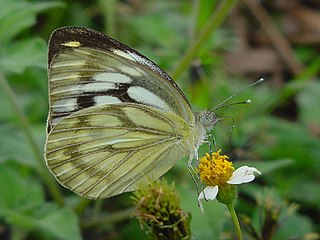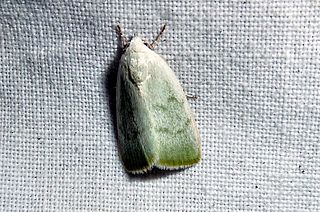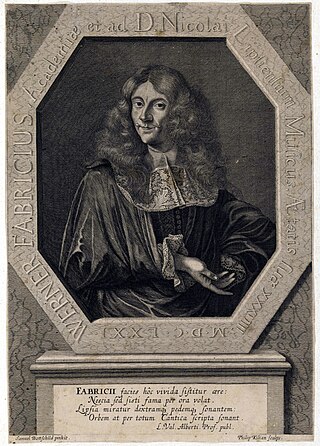
Johan Christian Fabricius was a Danish zoologist, specialising in "Insecta", which at that time included all arthropods: insects, arachnids, crustaceans and others. He was a student of Carl Linnaeus, and is considered one of the most important entomologists of the 18th century, having named nearly 10,000 species of animals, and established the basis for the modern insect classification.

The Essex emerald is a moth of the family Geometridae. The species was first described by Johan Christian Fabricius in 1787 as Phalaena smaragdaria. It is distributed throughout the Palearctic region with records from many European countries. The British subspecies Thetidia smaragdaria maritima was last seen in 1991 in Kent and is now presumed extinct. In 2004 the moth was first recorded from Sweden.

The white-shouldered house moth is a species of gelechioid moth. It belongs to the subfamily Oecophorinae of the concealer moth family (Oecophoridae), just like the brown house moth. Though several presumed congeners of E. sarcitrella were described, its genus Endrosis is currently understood to be monotypic.

Amblyomma is a genus of hard ticks. Some are disease vectors, for example the Rocky Mountain spotted fever in United States or ehrlichiosis in Brazil.

Roeslerstammia erxlebella is a moth of the family Yponomeutidae. It is found in all of Europe, east to Japan.

Olindia schumacherana, also known as the white-barred tortrix, is a moth of the family Tortricidae found in most of Europe. The moth was first described by the Danish zoologist, Johan Christian Fabricius in 1787.

Cepora is a genus of butterflies, commonly called gulls, in the family Pieridae. The genus contains about 20 species shared between the Indomalayan and Australasian realms.

Micropterix tunbergella is a moth of the family Micropterigidae found in most of Europe. The moths are very small and can be found feeding on the pollen of hawthorn, oak and sycamore. The larva and pupa are unknown. The moth was described Johan Christian Fabricius in 1787.

Agapanthia is a genus of flat-faced longhorn beetle belonging to the family Cerambycidae, subfamily Lamiinae.

Saperda is a genus of flat-faced longhorn beetles belonging to the family Cerambycidae, subfamily Lamiinae. The genus was erected by Johan Christian Fabricius in 1775.

Earias vernana is a species of moth in the family Nolidae first described by Johan Christian Fabricius in 1787. It is found in most of southern and central Europe.

Ceroplesis is a genus of flat-faced longhorn beetle in the subfamily Lamiinae of the family Cerambycidae.

Saperdini is a tribe of longhorn beetles of the subfamily Lamiinae.

Glenea is a genus of longhorn beetles belonging to the family Cerambycidae, subfamily Lamiinae.
Glenea acuta is a species of beetle in the family Cerambycidae. It was described by Johan Christian Fabricius in 1801. It is known from Sumatra and Java.

Glenea dimidiata is a species of beetle in the family Cerambycidae. It was described by Johan Christian Fabricius in 1801. It is known from Malaysia and Indonesia.
Glenea fasciata is a species of beetle in the family Cerambycidae. It was described by Johan Christian Fabricius in 1781. It has a wide distribution in Africa. It feeds on Coffea canephora and Theobroma cacao. It contains the varietas Glenea fasciata var. calabarica.

Fabricius Werner (1633-1679), an organist and composer of note, was born April 10, 1633, at Itzehoe, Holstein. As a boy he studied music under his father, Albert Fabricius, organist in Flensburg, and Paul Moth, the Cantor there. He went to the Gymnasium in Hamburg, where Thomas Selle and Heinrich Scheidemann were his teachers in music. In 1650 he went to the Leipzig University, studying philosophy, theology, and law; in the latter he became a fully qualified 'Notar.' He was appointed Musik-Director of the Paulinerkirche, Leipzig, in 1656, and in 1658 was also appointed organist to the Nicolaikirche. Although he tried for the post of Cantor to the Thomaskirche in March 1658, he was not elected. He was married July 3, 1665, and one son survived him, Johann Albert Fabricius. He died Jan. 9, 1679, at Leipzig, forty-five years old, according to the contemporary account of him in Musica Davidica, order Davids Music, bei der Leichbe-stattung des ... Hern Werneri Fabricii ... durch Joh. Thilone, ad S. Nicolaum Ecclesiaste.
















